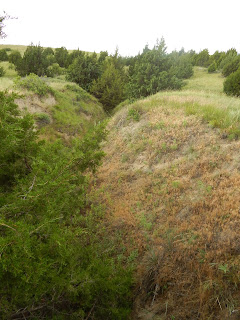By: Johnica Morrow
The final week of third session has begun! Last week we saw the arrival and departure of three artists in residence and the scampering of students perfecting projects that will be due by the end of this week. This week is sure to be just as eventful. Students continue to monitor their crayfish, toads, minnows, snails, and damselflies that are being treated with everything from clay to antibiotics. We have also welcomed a new set of artists to the campus.
Art Continues at Cedar Point
Last Thursday, our three artists, Zach Jacobs, Trudie Teijink, and Kelly Weber, were kind enough to share their work with an audience of students, professors, and staff members. Zach is working on a creative non-fiction piece about his time working on an archaeological excavation in Turkey. Trudie is a printmaker working on a number of different pieces inspired by Lake Ogallala and parts of the surrounding landscape. Kelly is a poet who is also working on various pieces inspired by nature and the study thereof. Each of these artists had unique perspectives of the region and chose CPBS as the place to hone their skills and fine-tune their products. We were glad to have them and elated for them to share their works in progress with those of us living, working, and learning here at the station.
 |
| Kelly, Zach, and Trudie smile after presenting their projects to a CPBS audience. |
 |
| Associate director, Jon Garbisch, enjoys the artists' presentations. |
Epidemiology at Otter Creek
 |
| Students capturing damselflies at Otter Creek. |
 |
| Field Epidemiology, 2015 |
 |
| Dr. Nickol points to the grave memorial for local cholera victim who died on the Oregon Trail. |
Before heading back to the station, the class made one last stop at Windlass Hill. This area was a difficult place for travelers to traverse with their wagons. The ruts from these treks are still visible, and mark the entrance into the Ash Hollow area and into the North Platte River Valley. Students hiked to the top of Windlass Hill to see the landscape unfold before them, fairly different than the view seen by those traveling along the Oregon Trail so many years ago, but still retaining the scars from the treacherous crossings made by early 19th century Americans.
| Field Epidemiology student, Megan Wright, begins the trek up to Windlass Hill. |
Culinary Art in Oatmeal
The fact that our kitchen staff prepares a wide range of different oatmeal flavors isn't new. The "Oatmeal of the Day" was a thing that started last summer. However, it hasn't really been talked about here on our blog, so I felt compelled to let all of you other CPBS fans out there know about a tradition that has carried over into this summer.
Even those of us who like oatmeal and recognize how healthy it can be for you can easily see how it would get boring day in and day out. There's only so many things you can put in it, right? Wrong! Our kitchen staff puts their culinary creativity to work almost every day as they prepare traditional and totally inventive versions of this classic breakfast food. We've had everything from your standard cinnamon-raisin, strawberries and cream, and blueberry oatmeals to deliciously different concoctions such as lemon poppyseed, pina colada, and coconut lime.

"It's fun working in the kitchen because we have the freedom to make all kinds of different things," says Sam Pellatz, a member of this summer's kitchen staff, "Especially, with making the oatmeal, we have complete culinary freedom to make whatever kind we want for the day. Be it classic or completely off of the wall. There are no limits."
Some of the other featured oatmeals of the day have included trail mix, cranberry orange, banana nut, red velvet cake, apple cinnamon, peanut butter banana, strawberry chocolate, turtle, peaches and cream, and pumpkin pie. There have been many other fun flavors over the last two summers and the staff members are continually working to create new and exciting dishes to start our mornings off right. I can't wait to see what they come up with next!

















